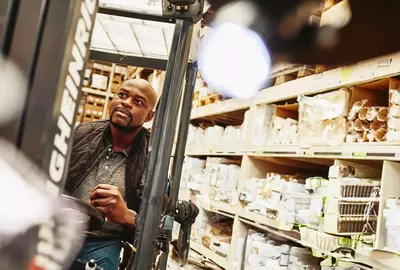Logistics was one of the first industries hit hard when the global pandemic began. With instant lockdowns, quarantines and strict travel restrictions, the ability to store, move and distribute products became nearly impossible. Store shelves became empty, shipping containers piled up off the coast, and businesses struggled to find the supplies they needed to meet consumer demands.
Supply chain shortages across the globe rose by an astonishing 638% in just the first half of 2021. These disruptions forced business leaders to instantly adjust their supply chain processes and seek out new distributors and means of acquiring raw materials. Alternatively, organizations within the logistics industry worked hard to mitigate these supply chain disruptions for their clients.
Despite markets reopening and COVID-19 restrictions starting to ease, 73% of global business executives still rank supply chain shortages as one of their top concerns. If the supply chain crisis is impacting your organization, the first step to mitigating its impact on your company is to understand the causes behind it. Keep reading to learn more.
what is the supply chain shortage?
In short, supply chain is the process of producing and distributing products from a supplier to a company and then to the customer. A supply chain shortage occurs when one or more steps in this process are disrupted, which causes a delay in the delivery of products to the customer or makes it impossible to meet consumer demands.
Prior to the pandemic, most supply chain shortages only impacted one or two industries at a time or caused short delays. For example, in 2000, Firestone recalled 6.5 million tires due to safety concerns, which led to a temporary tire shortage in the United States. Alternatively, a national disaster could lead to a temporary shortage of supplies due to damages and factory shutdowns in those areas.
While many organizations invest in supply chain planning and forecasting, nothing could have prepared them for the disruptions caused by a global pandemic. This supply chain crisis impacted nearly every industry in every region of the world.
understanding the current supply chain crisis
download the guidewhy is there a supply chain shortage?
Even before the pandemic hit, the supply chain was a complex process that included multiple steps and layers. Just one disruption in this process can lead to significant shortages. So, when the pandemic hit, many businesses were left unprepared.
While COVID-19 may be considered the catalyst of the current supply chain crisis, that’s much too broad of a topic to fully explain the current issues. There are several reasons spurring the ongoing supply chain disruptions.
travel restrictions
China is responsible for producing nearly 29% of all global products. So, when it was the first country to face travel restrictions, the impact on the supply chain was noticed almost instantly. This caused a ripple effect throughout the world as organizations struggled to find new suppliers to meet demand. Brexit, which took effect less than two months prior to the start of the pandemic, also impeded the movement of both product and talent throughout Europe.
Cargo ships were literally unable to dock to offload goods and trucks were stopped at the borders with full loads. With globalization at an all-time high, the lack of international trade disrupted supply chain processes in nearly every industry throughout the world. These disruptions also significantly impacted many businesses’ ability to obtain the materials necessary to meet their production demands.
While borders are now reopening and international trading is inching towards pre-pandemic levels, businesses are still experiencing supply chain shortages and delays due to border controls. While some of this is likely to ease with time, it could take years to reestablish some of these broken supply chains.
talent shortage
The ongoing talent shortage combined with the growing skills gap certainly plays a role in the current supply chain crisis. Having the right workers in the right roles is critical for supply chain efficiencies.
At the onset of the pandemic, quarantines and shutdowns led to a loss of 114 million jobs in 2020 alone. While COVID-19 restrictions are starting to subside and markets reopening, employers are still struggling to acquire and retain the talent they need.
This talent shortage has its own set of unique causes including the aging population, continuing COVID-19 concerns, the great resignation and shifting workers’ demands. Despite the reasons, the lack of workers is significantly impacting organizations' abilities to mitigate supply chain disruptions.
For example, the United States has seen a labor shortage of 80,000 truck drivers. This problem isn’t limited to just the U.S. The International Road Transport Union reports that 20% of trucking jobs went unfilled across 20 Eurasia countries in 2021. Without truckers, the ability to move products between locations becomes even more challenging.
When it comes to the supply chain industry, filling vacant jobs isn’t an easy task. Not only are we dealing with an ongoing labor shortage, but many of these roles also require specialized skills and experience. For example, truck drivers must have the right licensing and experience. Alternatively, workers handling supply chain management must have experience in material planning and forecasting.
Additionally, the supply chain is more tech-driven today than ever before. Even production lines and warehouses are equipped with robotics and automation technology. For this technology to operate efficiently, organizations need tech-savvy workers. And not just software coding specialists and data analysts. They also require lower-level workers with technical skills and experience. Unfortunately, a recent study shows that only 1% of companies believe that they have the digital in-house talent they need.
limited inventory
As supply chain planning, management and forecasting have become more sophisticated and accurate over the years, businesses began incorporating a close to capacity supply chain business model. This means that many organizations store less on-site inventory. Instead, they depend on their complex supply chain network to deliver the supplies they need, when they need them.
Prior to the pandemic, this new business model worked fairly well, and organizations were often able to mitigate most supply chain disruptions. This model allows businesses to cut costs and improve workplace efficiencies without sacrificing quality or impeding the production process. However, when COVID-19 suddenly halted various stages of the supply chain process, some companies found themselves only days away from significant supply shortages.
The problem is that this type of business model requires accurate forecasting, which advanced technology allowed for up to this point. It didn’t, however, prepare organizations for a global pandemic or the level of supply chain disruptions it caused. This unpredictable global crisis also made future forecasting, at least during the pandemic itself, even more challenging.
Additionally, businesses that relied heavily on trade with national and international distributors found themselves stuck when shutdowns and travel restrictions hit. These organizations were forced to transfer to local and regional distributors, who were also strained trying to meet increased demands.
As a result, business leaders pledged to build more local and regional supply chain networks to protect themselves from future disruptions. According to one study, 38% of global businesses intended to regionalize their supply chain network. Despite this pledge, however, a follow-up study revealed that only 25% took steps to build a supply chain network that focused on local and regional suppliers. Instead, 61% of these businesses increased their on-site inventories.
This could be just a short-term solution because 90% of the businesses surveyed still have plans to regionalize their supply chain networks at some point in the future. This shift could be a golden opportunity for smaller, more localized businesses to fill in the gap.
global impact of ongoing supply chain disruptions
Ongoing supply chain shortages have impacted businesses across the world in a variety of ways, including:
-
inability to meet customer demand
According to a recent study, organizations’ biggest supply chain challenge is securing raw materials from suppliers. Some of these business leaders admit that lack of diversification in their supply chain network is partially to blame, but also note that suppliers’ inability to keep up with technological advancements is also hindering supply chain processes.
No matter what the reasons are, if your company can’t secure the materials it needs for production, it can be next to impossible to meet consumer demands. We can see this failure in the supply chain process by the number of empty shelves in stores around the globe.
For your business, however, this failure in supply chain distribution means more than slow delivery of products. It could cause the loss of customers, diminish revenue and ultimately affect the future success of the company. It’s crucial to take steps to strengthen your supply chain networks and processes to improve efficiencies and meet consumer demands.
-
longer lead times
Even if your company is able to secure the raw materials it needs for production, the combination of delivery delays and talent shortages can lead to longer lead times or the time it takes to complete an order. As a business leader, you already know that any delay in the production process is costly. It can decrease production, diminish customer confidence, reduce sales and impact revenue.
Typically, companies have the capabilities to mitigate a few disruptions within the supply chain. The current supply chain shortages, however, are impacting everything from production to delivery. It’s causing a bottleneck in production processes across industries. For example, the computer chip shortage led to an 11.3 million production unit loss in the automobile industry alone. Another example impacting the auto industry is the shortage of wire harnesses due to the Ukraine-Russian conflict. Car manufacturers, including BMW, Volkswagen and Porsche, have already announced production disruptions that are likely to last months until alternative suppliers are found.
As all business leaders know, longer lead times can result in lower output, higher costs and reduced revenue.
-
increased supply costs
As if supply chain shortages aren’t enough, the increased demand and growing inflation concerns are leading to higher material and supply costs. If your organization, like many, is already facing budget constraints as you try to navigate in a post-pandemic market, higher supply costs make this process even more difficult. Now, companies not only have to develop new supply chain networks that allow them to secure the raw materials they need, but they must also make cost efficiency a top priority.
On top of this, businesses are facing yet another uphill battle — increased fuel costs. The Russian-Ukraine conflict has driven fuel prices higher on a near-daily basis. In the United States, gas prices have hit an all-time high and petrol costs in Europe have spiked as high as 62% in some areas.
These increased costs, in turn, are being passed on to organizations that are already dealing with higher costs due to demand and inflation. For example, Amazon recently announced that it will charge its third-party sellers a 5% fuel fee. Companies must make tough decisions regarding their supply chain network to control costs if they hope to remain competitive.
who is affected most by these supply chain shortages?
Ultimately, everyone from producers and distributors to retailers and consumers are affected by the current supply chain crisis. However, the industries hit the hardest are those right in the midst of the supply chain network, including manufacturing and logistics, as well as retailers who depend on the delivery of goods.
For example, manufacturing is undeniably one of the hardest-hit industries. A delay in just one required raw material could halt production altogether. Today, many manufacturers aren’t dealing with just one supply delivery delay. Instead, they’re facing multiple supply chain shortages that are impacting several stages of the production process simultaneously. These companies are finding it difficult to meet staffing and production needs.
Here’s a look at several examples of how the current supply chain crisis is impacting businesses and consumers.
- auto industry: expected to lose over $200 billion in global revenue due to semiconductor shortage alone.
- construction industry: lumber prices have more than doubled since the pandemic, impacting everything from new construction to home renovations.
- shipping industry: suppliers’ delivery times reached an all-time high in the United States and European Union.
- consumers: the Consumer Price Index rose by 3.6% in the EU and by 6.2% in the U.S. in September 2021.
when will the supply chain return to normal?
While it may have taken mere days to see disruptions in the supply chain process due to the global pandemic, it’s going to take longer to repair these damages. Most experts agree that supply chain disruptions are likely to last throughout 2022, but the reality is that it could take years for these networks to be built back up to pre-pandemic levels.
The continuation of the talent shortage will certainly play a role in this recovery. If organizations can’t secure the talent they need to meet consumer demands, it could prolong supply chain recovery. Additionally, if suppliers can’t acquire the digital skills they need to implement new technology, it could take even longer to resolve some of the more complex supply chain issues.
If your company, like many across the globe, is facing challenges due to the supply chain shortage, the first step to overcoming these obstacles is to clearly understand the causes and effects of this crisis. Download our presentation on the supply chain crisis.







